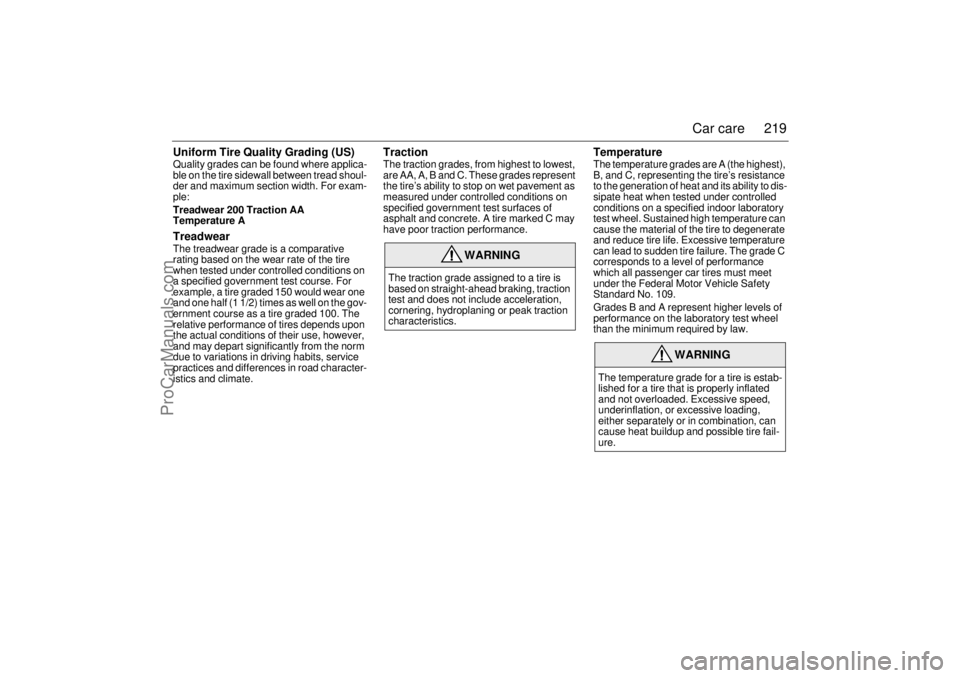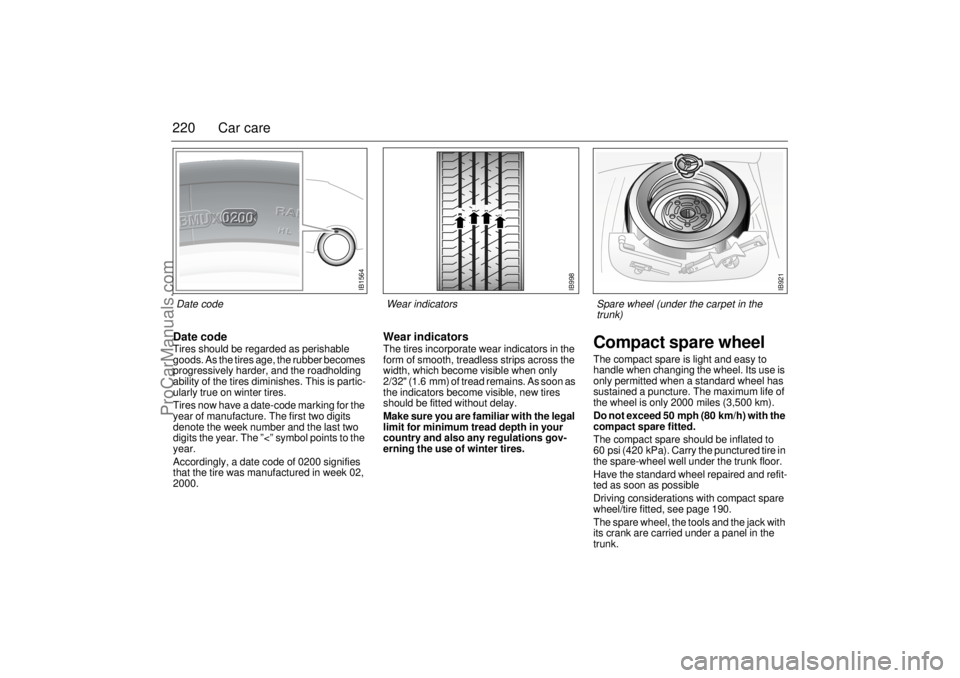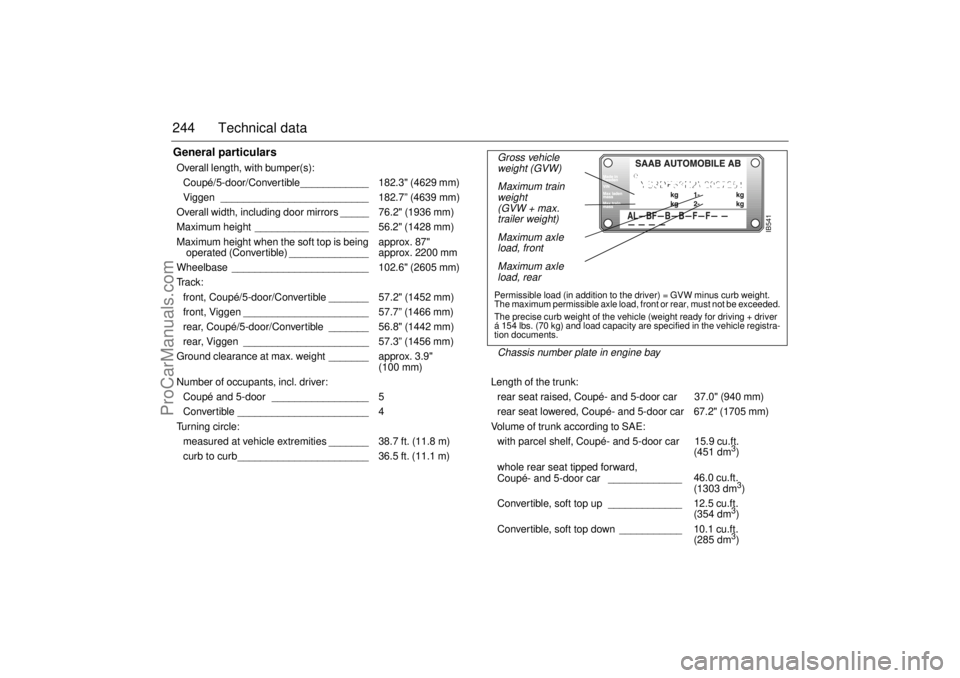width SAAB 9-3 2001 Owners Manual
[x] Cancel search | Manufacturer: SAAB, Model Year: 2001, Model line: 9-3, Model: SAAB 9-3 2001Pages: 260, PDF Size: 12.01 MB
Page 218 of 260

218 Car careRotating the tires Because of front wheel drive, the front tires
tend to wear faster than the rear ones. New
tires should always be fitted in pairs, so that
tires on the same axle have the same
amount of tread.
If swapping the complete set, e.g. winter
tires for summer tires, mark the tires
removed to ensure that they go back in the
same position (e.g. FL for front left, RL rear
left, etc.).
Store wheels lying flat or hanging – never
standing upright.
Tire markingsAn example of the meaning of the different
markings in a tire size is given below for a
tire size of 195/60 R15 88V:
Winter tiresWinter (snow) tires are recommended for
winter climates where the majority of your
driving will be done on snow and ice. Winter
tires should be fitted to all four wheels to
maintain a proper balance. Your Saab
dealer can advise you of to the correct size
tire for your car (if different from the original
size) and also supply Saab approved winter
tires pre-mounted on steel or alloy rims.Tire quality grading (cars sold in
U.S.)New tires must be graded and labeled in
accordance with new Federal regulations.
Standard tests are conducted to measure
performance in the areas of traction and
temperature resistance. Refer to the tire
sidewall for the specific quality grades of the
tires provided on your new Saab. Compact
spare tires are exempt.
DOT QUALITY GRADES
Treadwear.
Traction AA, A, B, C.
Temperature A, B, C.
All passenger car tires must conform to Fed-
eral safety requirements in addition to these
grades.
WARNING
When fitting just one new pair of tires,
these should be fitted to the rear wheels,
as these are more critical to the direc-
tional stability of the car (e.g. on braking
or in a skid). The existing rear tires should
therefore be moved to the front. Always
move left rear to left front and right rear to
right front, so that the direction of rotation
remains the same.
195 Tire section width, mm
60 Aspect ratio, i.e. the section height
is 60 % of the section width
R Radial ply
15 Wheel rim diameter 15 in. at bead
seats
88 Tire load code
V Speed marking
Speed ratingsS Tire approved for speeds up to
112 mph (180 km/h)
T Tire approved for speeds up to
118 mph (190 km/h)
H Tire approved for speeds up to
130 mph (210 km/h)
V Tire approved for speeds up to
150 mph (240 km/h)
W Tire approved for speeds up to
167 mph (270 km/h)
Y Tire approved for speeds up to
186 mph (300 km/h)
ProCarManuals.com
Page 219 of 260

219 Car care
Uniform Tire Quality Grading (US)Quality grades can be found where applica-
ble on the tire sidewall between tread shoul-
der and maximum section width. For exam-
ple:
Treadwear 200 Traction AA
Temperature ATreadwearThe treadwear grade is a comparative
rating based on the wear rate of the tire
when tested under controlled conditions on
a specified government test course. For
example, a tire graded 150 would wear one
and one half (1 1/2) times as well on the gov-
ernment course as a tire graded 100. The
relative performance of tires depends upon
the actual conditions of their use, however,
and may depart significantly from the norm
due to variations in driving habits, service
practices and differences in road character-
istics and climate.
TractionThe traction grades, from highest to lowest,
are AA, A, B and C. These grades represent
the tire’s ability to stop on wet pavement as
measured under controlled conditions on
specified government test surfaces of
asphalt and concrete. A tire marked C may
have poor traction performance.
TemperatureThe temperature grades are A (the highest),
B, and C, representing the tire’s resistance
to the generation of heat and its ability to dis-
sipate heat when tested under controlled
conditions on a specified indoor laboratory
test wheel. Sustained high temperature can
cause the material of the tire to degenerate
and reduce tire life. Excessive temperature
can lead to sudden tire failure. The grade C
corresponds to a level of performance
which all passenger car tires must meet
under the Federal Motor Vehicle Safety
Standard No. 109.
Grades B and A represent higher levels of
performance on the laboratory test wheel
than the minimum required by law.
WARNING
The traction grade assigned to a tire is
based on straight-ahead braking, traction
test and does not include acceleration,
cornering, hydroplaning or peak traction
characteristics.
WARNING
The temperature grade for a tire is estab-
lished for a tire that is properly inflated
and not overloaded. Excessive speed,
underinflation, or excessive loading,
either separately or in combination, can
cause heat buildup and possible tire fail-
ure.
ProCarManuals.com
Page 220 of 260

220 Car careDate codeTires should be regarded as perishable
goods. As the tires age, the rubber becomes
progressively harder, and the roadholding
ability of the tires diminishes. This is partic-
ularly true on winter tires.
Tires now have a date-code marking for the
year of manufacture. The first two digits
denote the week number and the last two
digits the year. The ”<” symbol points to the
year.
Accordingly, a date code of 0200 signifies
that the tire was manufactured in week 02,
2000.
Wear indicatorsThe tires incorporate wear indicators in the
form of smooth, treadless strips across the
width, which become visible when only
2/32" (1.6 mm) of tread remains. As soon as
the indicators become visible, new tires
should be fitted without delay.
Make sure you are familiar with the legal
limit for minimum tread depth in your
country and also any regulations gov-
erning the use of winter tires.
Compact spare wheelThe compact spare is light and easy to
handle when changing the wheel. Its use is
only permitted when a standard wheel has
sustained a puncture. The maximum life of
the wheel is only 2000 miles (3,500 km).
Do not exceed 50 mph (80 km/h) with the
compact spare fitted.
The compact spare should be inflated to
60 psi (420 kPa). Carry the punctured tire in
the spare-wheel well under the trunk floor.
Have the standard wheel repaired and refit-
ted as soon as possible
Driving considerations with compact spare
wheel/tire fitted, see page 190.
The spare wheel, the tools and the jack with
its crank are carried under a panel in the
trunk.
IB1564
Date code
IB998
Wear indicators
IB921
Spare wheel (under the carpet in the
trunk)
ProCarManuals.com
Page 244 of 260

244 Technical dataGeneral particularsOverall length, with bumper(s):
Coupé/5-door/Convertible____________ 182.3" (4629 mm)
Viggen __________________________ 182.7” (4639 mm)
Overall width, including door mirrors _____ 76.2" (1936 mm)
Maximum height ____________________ 56.2" (1428 mm)
Maximum height when the soft top is being
operated (Convertible) ______________approx. 87"
approx. 2200 mm
Wheelbase ________________________ 102.6" (2605 mm)
Tr a c k :
front, Coupé/5-door/Convertible _______ 57.2" (1452 mm)
front, Viggen ______________________ 57.7” (1466 mm)
rear, Coupé/5-door/Convertible _______ 56.8" (1442 mm)
rear, Viggen ______________________ 57.3” (1456 mm)
Ground clearance at max. weight _______ approx. 3.9"
(100 mm)
Number of occupants, incl. driver:
Coupé and 5-door _________________ 5
Convertible _______________________ 4
Turning circle:
measured at vehicle extremities _______ 38.7 ft. (11.8 m)
curb to curb_______________________ 36.5 ft. (11.1 m)
Gross vehicle
weight (GVW)
Maximum train
weight
(GVW + max.
trailer weight)
Maximum axle
load, front
Maximum axle
load, rear Permissible load (in addition to the driver) = GVW minus curb weight.
The maximum permissible axle load, front or rear, must not be exceeded.
The precise curb weight of the vehicle (weight ready for driving + driver
á 154 lbs. (70 kg) and load capacity are specified in the vehicle registra-
tion documents.Chassis number plate in engine bay Length of the trunk:
rear seat raised, Coupé- and 5-door car 37.0" (940 mm)
rear seat lowered, Coupé- and 5-door car 67.2" (1705 mm)
Volume of trunk according to SAE:
with parcel shelf, Coupé- and 5-door car 15.9 cu.ft.
(451 dm
3)
whole rear seat tipped forward,
Coupé- and 5-door car _____________ 46.0 cu.ft.
(1303 dm3)
Convertible, soft top up _____________ 12.5 cu.ft.
(354 dm3)
Convertible, soft top down ___________ 10.1 cu.ft.
(285 dm3)
IB541
ProCarManuals.com